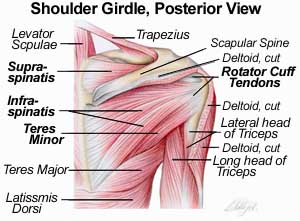MUSCLES
The rotator cuff is comprised of four small muscles at the shoulder joint: SUPRASPINATUS, INFRASPINATUS, TERES MINOR, and SUBSCAPULARIS. Their main function is to stabilize the head of the humerous in the glenoid cavity during movements of the shoulder. These muscles can be remembered with the acronym "SITS."
MUSCLE MEDIAL ATTACHMENT LATERAL ATTACHMENT ACTIONS INNERVATION SUPRASPINATUS Medial two-thirds of supraspinatus fossa of scapula. Superior facet of the greater tubercle of humerus. Abduction of the shoulder joint. Suprascapular nerve, (C5). INFRASPINATUS Medial aspect of infraspinatus fossa of scapula. Middle facet on the posterior aspect of the greater tubercle of humerus. External rotation of the shoulder joint. Suprascapular nerve, (C5). TERES MINOR Upper two-thirds of posterior surface of lateral border of scapula. Inferior facet on the posterior aspect of the greater tubercle of humerus, below infraspinatus attachment. External rotation of the shoulder joint. Axillary nerve, (C5, C6). SUBSCAPULARIS Subscapular fossa on the anterior aspect of scapula. Lesser tubercle of humerus. Internal rotation of the shoulder joint. Upper and lower branches of the Subscapular nerve, (C5, C6).

The rotator cuff muscles play a key role not only in shoulder stability, but also in the initiation of any shoulder movement.
